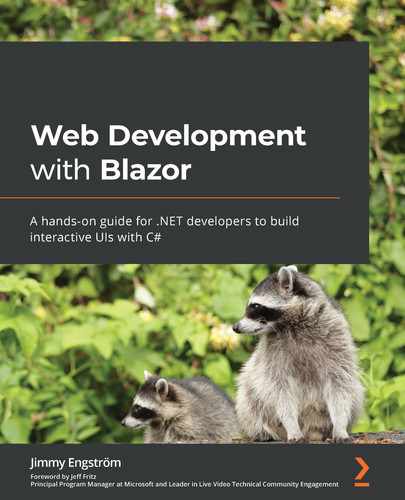Learn modern web user interface (UI) development with server-side Blazor and Blazor WebAssembly Until now, creating interactive web pages meant involving JavaScript. But with Blazor, Microsoft's new way to create .NET web applications, developers can easily build interactive and rich web applications using C#. Web Development with Blazor will guide you through the most common challenges in getting started with Blazor. You'll start by learning how to leverage the power of Blazor and learn what you can do with both Blazor Server and Blazor WebAssembly. By showing you how all the elements work together practically, the book will help you solve some of the common roadblocks that developers face. As you advance, you'll learn how to create Blazor Server and Blazor WebAssembly projects, how Razor syntax works, and how to validate forms and create your own components. Later, the book introduces you to key concepts involved in web development with Blazor, which you will be able to put into practice straight away. By the end of this Blazor book, you'll have gained the confidence you need to create and deploy production-ready Blazor applications. This web development book is for web developers and software developers who want to explore Blazor for building dynamic web UIs. This book assumes beginner-level knowledge of C# programming and intermediate-level web development skills.Key Features
Book Description
What you will learn
Who this book is for
Table of Contents
- Web Development with Blazor
- Foreword
- Contributors
- About the author
- About the reviewers
- Preface
- Section 1:The Basics
- Chapter 1: Hello Blazor
- Chapter 2: Creating Your First Blazor App
- Technical requirements
- Setting up your development environment
- Windows
- macOS
- Linux (or macOS or Windows)
- Creating our first Blazor application
- Creating a Blazor Server application
- Creating a WebAssembly application
- Using the command line
- Creating a Blazor Server project using the command line
- Figuring out the project structure
- Program.cs
- Startup
- Index/_host
- App
- MainLayout
- Bootstrap
- Summary
- Section 2:Building an Application with Blazor
- Chapter 3: Introducing Entity Framework Core
- Chapter 4: Understanding Basic Blazor Components
- Technical requirements
- Exploring components
- counter
- FetchData
- Learning Razor syntax
- Razor code blocks
- Implicit Razor expressions
- Explicit Razor expressions
- Expression encoding
- Directives
- Understanding dependency injection
- Figuring out where to put the code
- Lifecycle events
- Parameters
- Cascading parameters
- Writing our first component
- Summary
- Chapter 5: Creating Advanced Blazor Components
- Technical requirements
- Exploring binding
- One-way binding
- Two-way binding
- Adding Actions and EventCallback
- Using RenderFragment
- ChildContent
- Default value
- Building an alert component
- Exploring the new built-in component
- Setting the focus of the UI
- Influencing HTML head
- Component virtualization
- Summary
- Chapter 6: Building Forms with Validation
- Technical requirements
- Exploring form elements
- EditForm
- InputBase<>
- InputCheckbox
- InputDate<TValue>
- InputNumber<TValue>
- InputSelect<TValue>
- InputText
- InputTextArea
- InputRadio
- InputRadioGroup
- Adding validation
- ValidationMessage
- ValidationSummary
- Custom validation class attributes
- Building an admin interface
- Listing and editing categories
- Listing and editing tags
- Listing and editing blog posts
- Summary
- Chapter 7: Creating an API
- Chapter 8: Authentication and Authorization
- Chapter 9: Sharing Code and Resources
- Technical requirements
- Cleaning up the project
- Setting up the API
- Moving the components
- Cleaning up the shared files
- Adding the API
- Adding static files
- CSS versus LESS versus SASS
- Preparing CSS/SASS
- Adding CSS to MyBlogServerSide
- Adding CSS to MyBlogWebAssembly.Client
- Making the admin interface more useable
- Making the menu more useful
- Making the blog look like a blog
- Sharing problems
- CSS isolation
- Summary
- Chapter 10: JavaScript Interop
- Chapter 11: Managing State
- Technical requirements
- Storing data on the server side
- Storing data in the URL
- Route constraints
- Using a query string
- Scenarios that are not that common
- Implementing browser storage
- Creating an interface
- Implementing Blazor Server
- Implementing WebAssembly
- Implementing the shared
- Using an in-memory state container service
- Implementing real-time updates on Blazor Server
- Implementing real-time updates on Blazor WebAssembly
- Summary
- Section 3:Debug, Test, and Deploy
- Chapter 12: Debugging
- Chapter 13: Testing
- Chapter 14: Deploy to Production
- Chapter 15: Where to Go from Here
- Other Books You May Enjoy
